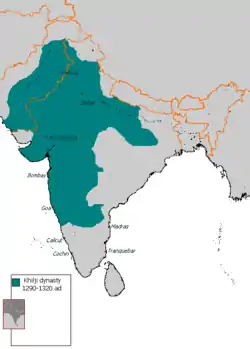دودمان خلجی
سلسله خلجی (به هندی: सलतनत ख़िलजी) یک سلسله پادشاهی ترکی-افغان[2] در شبهقاره هند و پایتخت آن دهلی بود[3][4][5] که در میان سالهای ۱۲۹۰ تا ۱۳۲۰ میلادی در بخش گستردهای از جنوب آسیا حکمرانی میکرد. این سلسله توسط جلالالدین فیروز خلجی تأسیس شد و دومین سلسله سلطنت دهلی بود. سلسله خلجی بخاطر فتوحاتش در حنوب هند و دفع حملات پیدرپی مغول به هند شناخته شدهاست.[6]
سلطنت خلجی | |||||||||
|---|---|---|---|---|---|---|---|---|---|
| ۱۲۹۰–۱۳۲۰ | |||||||||
 دودمان خلج | |||||||||
| پایتخت | دهلی | ||||||||
| زبان(های) رایج | فارسی (رسمی)[1] | ||||||||
| دین(ها) | اسلام | ||||||||
| حکومت | سلطنتی | ||||||||
| سلطان | |||||||||
• ۱۲۹۰–۱۲۹۶ | جلال الدین فیروز خلجی | ||||||||
• ۱۲۹۶–۱۳۱۶ | علاءالدین خلجی | ||||||||
• ۱۳۱۶ | شهاب الدین عمر | ||||||||
• ۱۳۱۶–۱۳۲۰ | قطب الدین مبارک شاه | ||||||||
| تاریخ | |||||||||
• بنیانگذاری | ۱۲۹۰ | ||||||||
• فروپاشی | ۱۳۲۰ | ||||||||
| |||||||||
| امروز بخشی از | هند پاکستان | ||||||||
تبار

خاندان خلجی اصالتی ترکی-افغان[2] داشتند. گفته میشود اجدادشان، خلجها در ابتدا قومی ترکتبار از آسیای میانه بودند و به همراه هونهای ایرانی و هپتالیها به مناطق جنوبی و شرقی افغانستان امروزی مهاجرت کردند.[7] آنها از اوایل سال ۶۶۰ تا سال ۸۷۰ میلادی به عنوان سلسله کابل شاهیان بر منطقه کابل فرمانروایی کردند.[8] خلجها از همان آغاز آمدن به ولایات پشتون نشین، در حال گذراندن فرایند جذب در سیستم قبایلی پشتون بودند و از سوی اشرافزادگان ترک سلطنت دهلی، با آنها به عنوان افغان رفتار میشد.[9][10][11]
زبان
زبان رسمی و درباری سلسله خلجی فارسی بود.[4][12] پس از آن عربی[4] و برخی از زبانهای بومی شمال هند بودهاست. هرچند فارسی، زبان مادری افراد این سلسله نبوده ولی سلاطین سلسله خلجی تشویق به استفاده از زبان فارسی میکردند. این استفاده از زبانهای مختلف باعث به وجود آمدن اولین فرم از زبان اردو شد.
شاهان
| لقب | نام | سلطنت |
|---|---|---|
جلال الدین |
ملک فیروز خلجی |
۱۲۹۰–۱۲۹۶ |
علاءالدین |
علی گرشاسپ خلجی |
۱۲۹۶–۱۳۱۶ |
شهاب الدین |
عمر خان خلجی |
۱۳۱۶ |
قطب الدین |
مبارک خان خلجی |
۱۳۱۶–۱۳۲۰ |
| خسرو خان در سال ۱۳۲۰ به کار سلسله خلجی پایان داد. | ||
جستارهای وابسته
منابع
- https://web.archive.org/web/20110929105219/http://asi.nic.in/asi_epigraphical_arabicpersian.asp
- Khan, Yusuf Husain (1971). Indo-Muslim Polity (Turko-Afghan Period). Indian Institute of Advanced Study.
- «خلجی | لغتنامه دهخدا». www.vajehyab.com. دریافتشده در ۲۰۲۱-۰۲-۲۶.
- "Arabic and Persian Epigraphical Studies - Archaeological Survey of India". Asi.nic.in. Archived from the original on 10 January 2019. Retrieved 2010-11-14.
- Yunus, Mohammad; Aradhana Parmar (2003). South Asia: a historical narrative. Oxford University Press. ISBN 0-19-579711-6. Retrieved 2010-08-23. Unknown parameter
|=ignored (help) - Barua, Pradeep (2005). The state at war in South Asia. U of Nebraska Press. p. 437. ISBN 0-8032-1344-1. Retrieved 2010-08-23.
- "ḴALAJ i. TRIBE – Encyclopaedia Iranica". iranicaonline.org. Retrieved 2021-01-15.
- Rezakhani, Khodadad (2017-03-15). ReOrienting the Sasanians: East Iran in Late Antiquity. Edinburgh University Press. p. 165. ISBN 978-1-4744-0030-5.
A Bactrian Document (BD T) from this period brings interesting information about the area to our attention. In it, dated to BE 476 (701 AD), a princess identified as `Bag-aziyas, the Great Turkish Princess, the Queen of Qutlugh Tapaghligh Bilga Sävüg, the Princess of the Khalach, the Lady of Kadagestan offers alms to the local god of the region of Rob, known as Kamird, for the health of (her) child. Inaba, arguing for the Khalaj identity of the kings of Kabul, takes this document as a proof that the Khalaj princess is from Kabul and has been offered to the (Hephthalite) king of Kadagestan, thus becoming the lady of that region. The identification of Kadagestan as a Hephthalite stronghold is based on Grenet's suggestion of the survival of Hephthalite minor stares in this region,' and is in con-
- Ashirbadi Lal Srivastava (1966). The History of India, 1000 A.D. -1707 A.D. (Second ed.). Shiva Lal Agarwala. p. 98. OCLC 575452554:"His ancestors, after having migrated from Turkistan, had lived for over 200 years in the Helmand valley and Lamghan, parts of Afghanistan called Garmasir or the hot region, and had adopted Afghan manners and customs. They were, therefore, wrongly looked upon as Afghans by the Turkish nobles in India as they had intermarried with local Afghans and adopted their customs and manners. They were looked down as non Turks by Turks."
- Abraham Eraly (2015). The Age of Wrath: A History of the Delhi Sultanate. Penguin Books. p. 126. ISBN 978-93-5118-658-8:"The prejudice of Turks was however misplaced in this case, for Khaljis were actually ethnic Turks. But they had settled in Afghanistan long before the Turkish rule was established there, and had over the centuries adopted Afghan customs and practices, intermarried with the local people, and were therefore looked down on as non-Turks by pure-bred Turks."
- Radhey Shyam Chaurasia (2002). History of medieval India: from 1000 A.D. to 1707 A.D. Atlantic. p. 28. ISBN 81-269-0123-3:"The Khaljis were a Turkish tribe but having been long domiciled in Afghanistan, had adopted some Afghan habits and customs. They were treated as Afghans in Delhi Court. They were regarded as barbarians. The Turkish nobles had opposed the ascent of Jalal-ud-din to the throne of Delhi."
- "زبان فارسی در سلسله خلجی".
| در ویکیانبار پروندههایی دربارهٔ دودمان خلجی موجود است. |
بخشی از مجموعه مقالات |
|---|
| تاریخ بنگلادش |
 |
|
|
|
